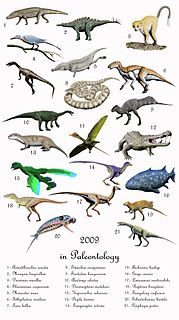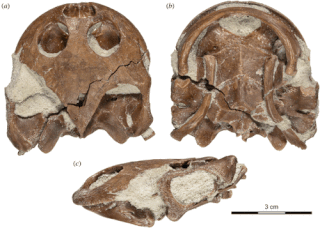
The Trionychidae are a taxonomic family of a number of turtle genera, commonly known as softshell turtles. The family was erected by Leopold Fitzinger in 1826. Softshells include some of the world's largest freshwater turtles, though many can adapt to living in highly brackish areas. Members of this family occur in Africa, Asia, and North America, with extinct species known from Australia. Most species have traditionally been included in the genus Trionyx, but the vast majority have since been moved to other genera. Among these are the North American Apalone softshells that were placed in Trionyx until 1987.

Testudinoidea is a superfamily within the suborder Cryptodira of the order Testudines. It includes the pond turtles, Asian turtles, the monotypic big-headed turtle, and the tortoises.

Rafetus is a genus of highly endangered softshell turtles in the family Trionychidae. It is a genus of large turtles which are found in freshwater habitats in Asia.
Tyler R. Lyson is an American paleontologist. He is the discoverer of the dinosaur fossil Dakota, a fossilized mummified hadrosaur. He has done significant research on the evolution of turtles and on the rise of mammals after the extinction of the dinosaurs.
Emarginachelys cretacea is a turtle belonging to the group Cryptodira, known from well preserved fossils from the Maastrichtian stage of the Late Cretaceous of Montana. Its exact phylogenetic position within Cryptodira is uncertain; different authors considered it to be either the earliest described chelydrid or a fossil relative of kinosternoids.

Paleontology or palaeontology is the study of prehistoric life forms on Earth through the examination of plant and animal fossils. This includes the study of body fossils, tracks (ichnites), burrows, cast-off parts, fossilised feces (coprolites), palynomorphs and chemical residues. Because humans have encountered fossils for millennia, paleontology has a long history both before and after becoming formalized as a science. This article records significant discoveries and events related to paleontology that occurred or were published in the year 2009.

Uluops is an extinct genus of paracryptodire turtle from the Late Jurassic (Tithonian) of North America. The type and only species is Uluops uluops, which is known from a single skull from the Morrison Formation.

Cedrobaena is an extinct genus of turtle which existed in the Tiffanian Cedar Point Quarry, Wyoming and in the latest Maastrichtian Hell Creek Formation, United States. It was first named by Tyler R. Lyson and Walter G. Joyce in 2009 and the type species is Cedrobaena putorius.
Gamerabaena is an extinct genus of baenid turtle which existed in North Dakota during the late Cretaceous Period. It is known from a single fragmentary skull that was found in the Maastrichtian-age Hell Creek Formation. It contains the species Gamerabaena sonsalla. Gamerabaena is similar to the genus Palatobaena, but it differs in its lack of a posterior expansion of the triturating surface, a somewhat rectangular skull, and a wide angle between the maxillae. Gamerabaena also has a lingual ridge on the inner side of the jaw that is not seen in Palatobaena.
Hutchemys is an extinct genus of softshell turtles from the late Cretaceous to the late Paleocene of New Mexico, Montana, Wyoming and Utah, United States. It was first named by Walter G. Joyce, Ariel Revan, Tyler R. Lyson and Igor G. Danilov in 2009, and the type species is Hutchemys rememdium. H. rememdium is known from the holotype YPM PU 16795, which consists of a nearly complete postcranial skeleton, and from the referred specimen YPM PU 16781, found in the Ekalaka Member of the Fort Union Formation, Montana. Another referred specimen, YPM PU 14985, was found in the Cedar Point Quarry, Wyoming. The second species, H. arctochelys, is known from the holotype YPM PU 16319, a nearly complete carapace, and from the paratypes YPM PU 16320, YPM PU 16321, YPM PU 16322, YPM PU 16238. All specimens of H. arctochelys were recovered from the same quarry of the Tongue River Member, Fort Union Formation, near Burns Mine of Montana. A possible third species is represented by the unnamed specimen UCMP 130000 from the Paleocene Tullock Formation of Montana. Aspideretes? nassau (YPM PU 11566) from the Fort Union Formation, Duffy's Ranch of Sweet Grass County, Montana was also assigned to Hutchemys sp.

Pangshura is a genus of geoemydid turtles endemic to South Asia. Its member species were formerly in the obsolete genus Kachuga. A fifth member, Pangshura tatrotia, was described in 2010, but it is only known from Pliocene fossils.
Palatobaena is an extinct genus of baenid turtle. It was first named by Gaffney in 1972 and the type species is Palatobaena bairdi. It based on a fragmentary skull from the Fort Union Formation of the Bighorn Basin of Wyoming. The two other species are P. gaffneyi and P. cohen which existed in Hell Creek Formation, North Dakota during the late Cretaceous period.
Gilmoremys is an extinct genus of softshell turtle which lived during the late Cretaceous of North Dakota, Montana and Wyoming, United States.

Baenidae is an extinct family of paracryptodiran turtles known from the Early Cretaceous to Eocene of North America. While during the Early Cretaceous they are found across North America, during the Late Cretaceous they are only found in Laramidia, having disappeared from Appalachia. The majority of lineages survived the K-Pg Extinction, but the family was extinct by the latest Eocene. The name of the type genus, Baena, appears to be of Native American origin. They are primarily found in freshwater deposits, and are considered to be aquatic, with a largely generalist habit.
Sokatra is an extinct genus of pleurodiran turtle, known from the Cretaceous (Maastrichtian) Maevarano Formation of Madagascar. It belongs to the family Sahonachelyidae.

Neurankylus is an extinct genus of turtles in the family Baenidae that lived between 112 and 61 million years ago in Canada and the United States. It was originally placed within the monotypic family Neurankylidae, but it has since been placed in the Neurankylinae, alongside Trinitichelys. The type species, Neurankylus eximius, was described by Lawrence Lambe in 1902. The species N. lithographicus was discovered in the Milk River Formation (Canada), alongside the holotype of the pachycephalosaurid dinosaur Acrotholus audeti.

Ankylopoda is a proposed clade that contains turtles and lepidosaurs and their fossil relatives. This clade is supported based on microRNAs as well as the fossil record. However, it is strongly contradicted by molecular evidence which supports Archelosauria.

Americhelydia is a clade of turtles that consists of sea turtles, snapping turtles, the Central American river turtle and mud turtles, supported by several lines of molecular work. Prior to these studies some morphological and developmental work have considered sea turtles to be basal members of Cryptodira and kinosternids related to the trionychians in the clade Trionychoidea.
Angolachelonia is a clade of extinct turtles from the Late Jurassic to Paleogene of Eurasia. The group is defined as all taxa derived from the ancestor of the type genus Angolachelys and Solnhofia, a definition that could potentially encompass a clade of entirely marine turtles. Angolachelonia was originally inclusive of only Solnhofia, Angolachelys and Sandownia when originally concevied by Octavio Mateus and colleagues in 2009, but later phylogenetic analyses by Serjocha Evers and Roger Benson in 2018 unites the family Sandownidae, including Angolachelys and Sandownia among other taxa, with the entirely Late Jurassic clade Thalassochelydia, where Solnhofia may be a basal member. While the placement of Solnhofia is weak and the clade that Angolachelonia represents may change with further analysis, the clade of Sandownidae and Thalassochelydia is well-supported, and does not collapse despite the uncertain evolutionary history of the group. Three alternative potential origins of Angolachelonia sensu Evers and Benson are shown below.

Sahonachelyidae is an extinct family of pelomedusoid turtles from the Late Cretaceous (Maastrichtian) Maevarano Formation of Madagascar. The clade was recognized in 2021 by Joyce et al., and contains two genera: Sahonachelys and Sokatra. The clade is characterized by the presence of a reduced contribution of the maxilla to the floor of the orbit, and, the presence of a distinct posterior process of the maxilla. The clade went extinct at the end of the Cretaceous period during the K-Pg extinction event.













